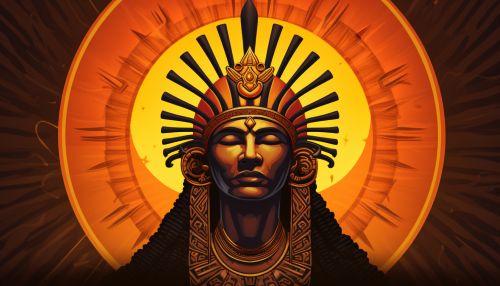Ra
Origins and Historical Development
Ra, also known as Re, is an ancient Egyptian sun god. His significance and worship in the Egyptian pantheon can be traced back to the Predynastic Period, around 5000 BCE. Over time, Ra became one of the most important deities in ancient Egypt, symbolizing the sun, creation, power, and kingship.


Iconography
Ra is often depicted as a man with the head of a falcon, crowned with a solar disk encircled by a serpent. This iconography represents his association with the sun and the sky. The sun disk, known as the "Aten", is a direct symbol of his solar dominion. The serpent, or "uraeus", represents sovereignty, deity, and divine authority in ancient Egyptian iconography.
Worship and Cult
The cult of Ra originated in Heliopolis (modern-day Cairo), which became the center of his worship. The Pyramid Texts, the oldest known religious texts in the world, reveal that the early pharaohs considered themselves to be sons of Ra, and they aligned themselves with the god to legitimize their rule. The cult of Ra reached its zenith during the Fifth Dynasty, where Ra became a state deity, and the pharaohs constructed solar temples in his honor.
Mythology
In Egyptian mythology, Ra is a creator deity. The Heliopolitan cosmogony, one of the various creation myths in ancient Egypt, states that Ra emerged from the primordial waters of Nun, bringing forth the universe through his divine speech. Each day, Ra travels across the sky in a solar barque and descends into the underworld at night, a journey that represents the cycle of life, death, and rebirth.
Syncretism with Other Deities
Over time, Ra was syncretized with several other deities in the Egyptian pantheon. The most notable of these syncretizations is Amun-Ra, a composite deity formed from the union of Ra and Amun, the god of Thebes. This syncretization represented the fusion of the sun god with the king of the gods, symbolizing the ultimate divine power.
Legacy
The worship of Ra declined after the rise of Christianity in the Roman Empire, but his legacy continues to influence modern culture. His iconography and myths have been adopted in various forms of media, including literature, film, and video games. Moreover, Ra's influence can be seen in the field of Egyptology, where his myths and symbols provide valuable insights into the religious and cultural practices of ancient Egypt.
